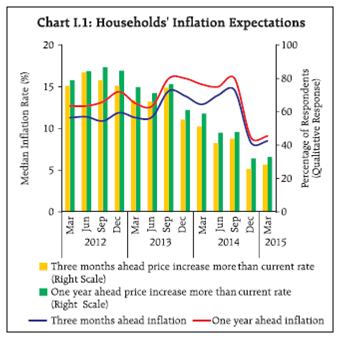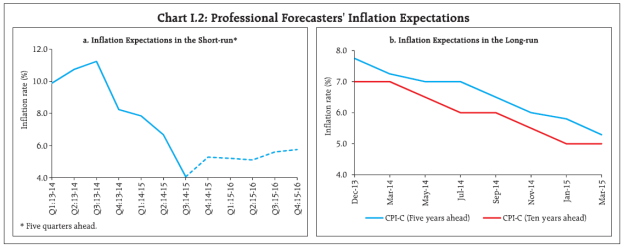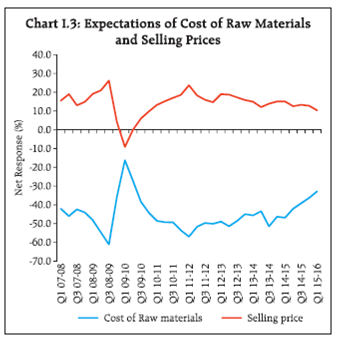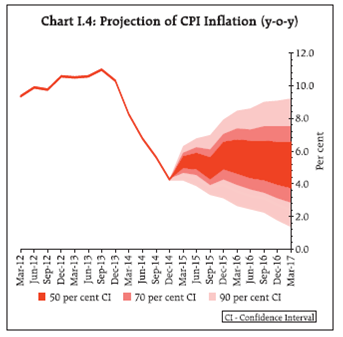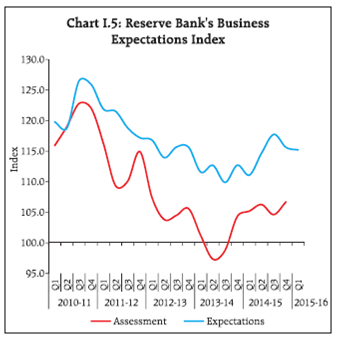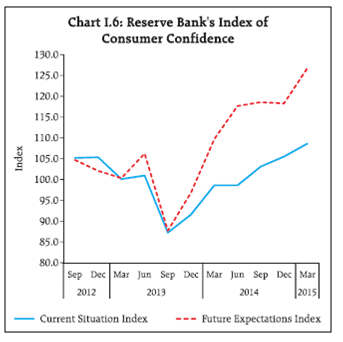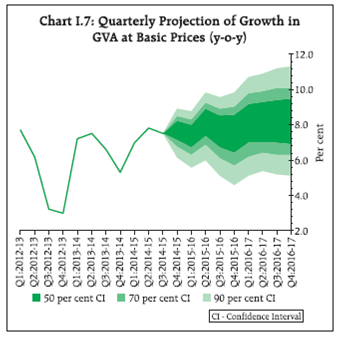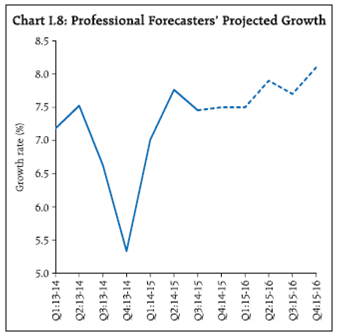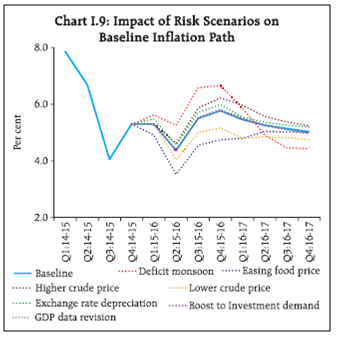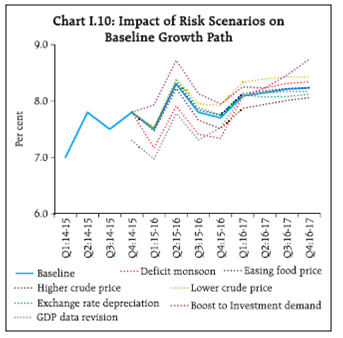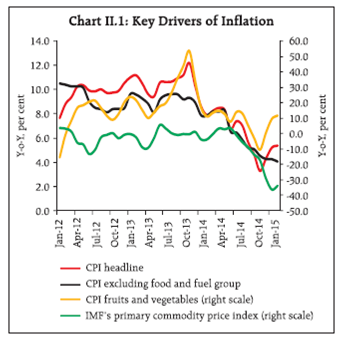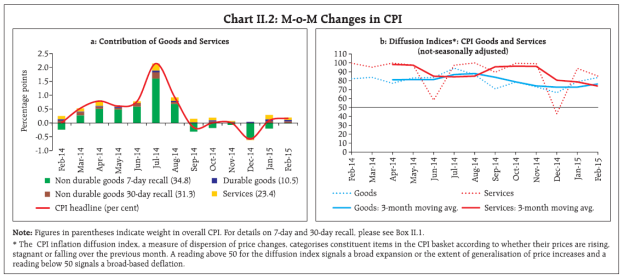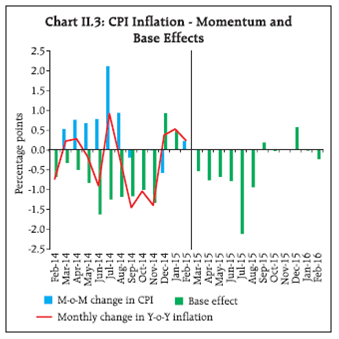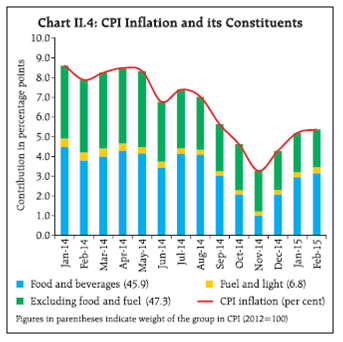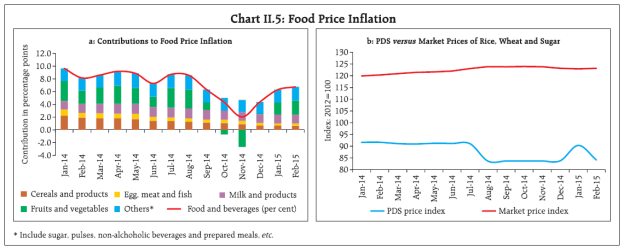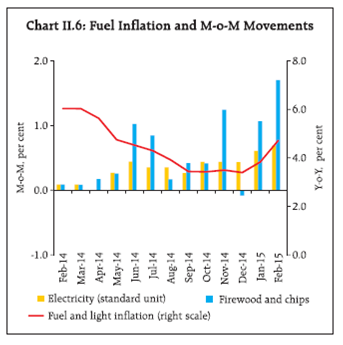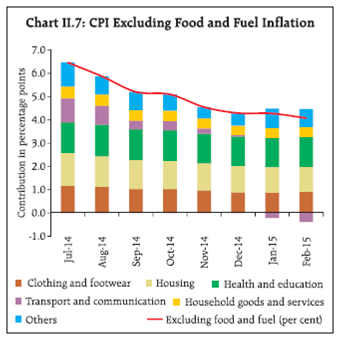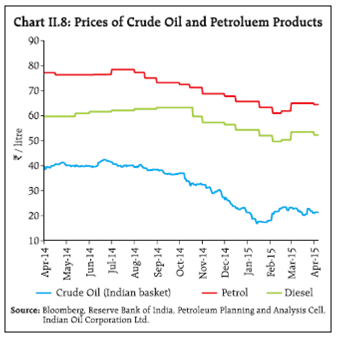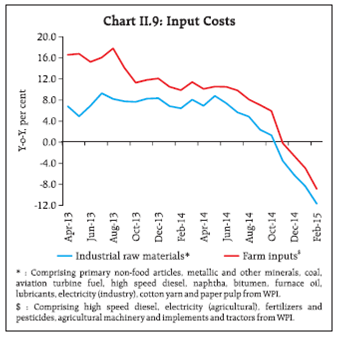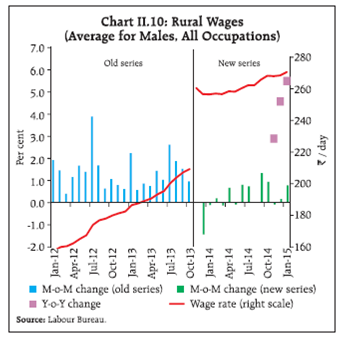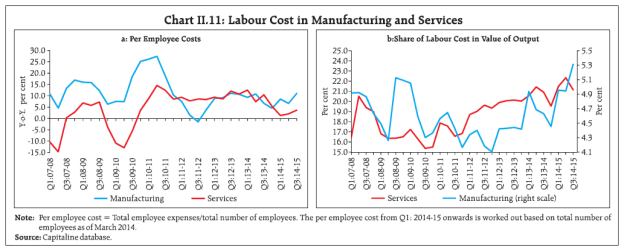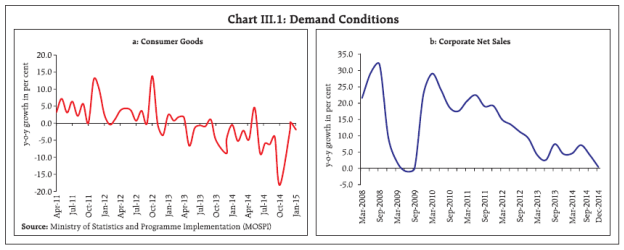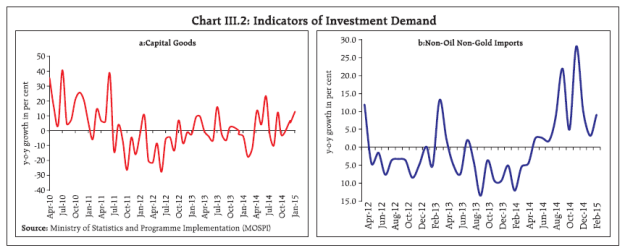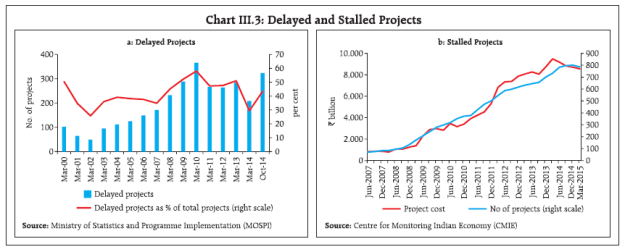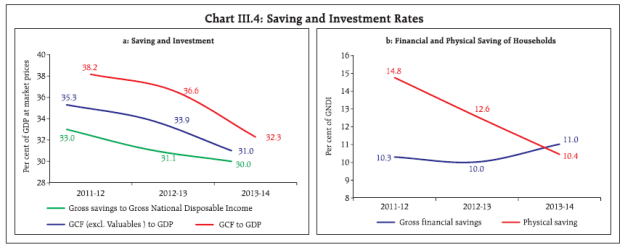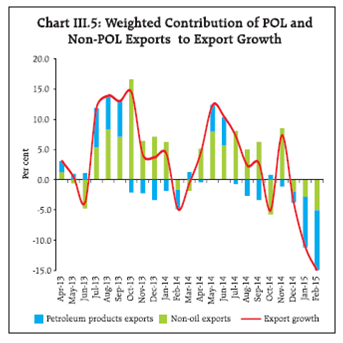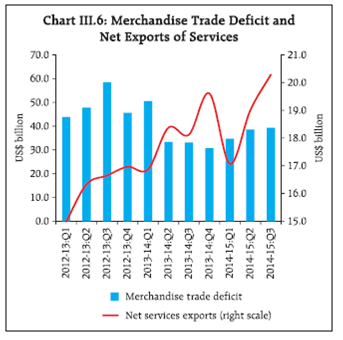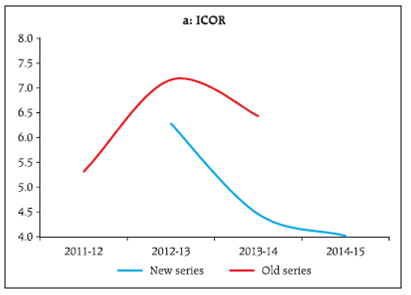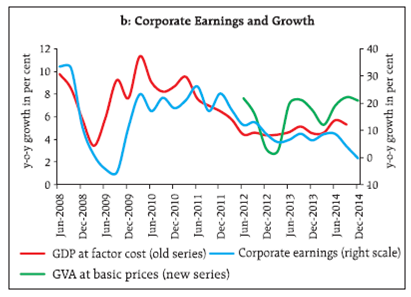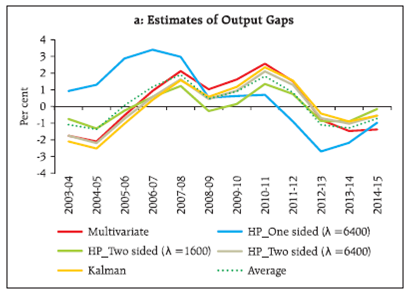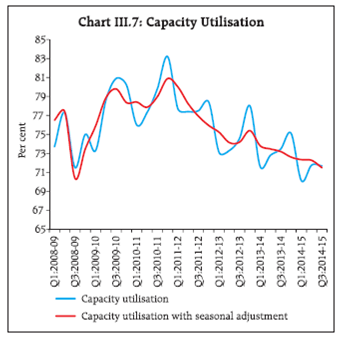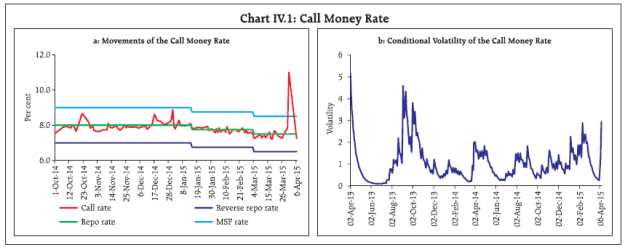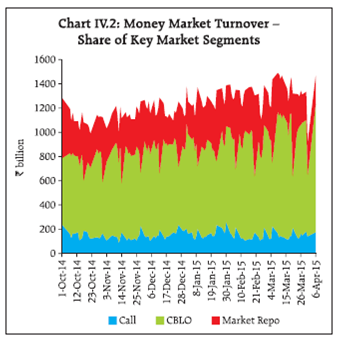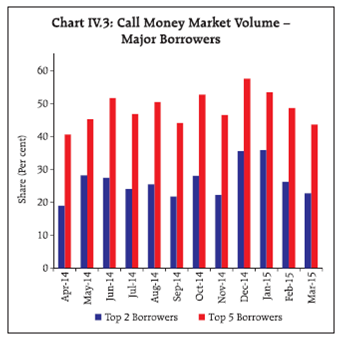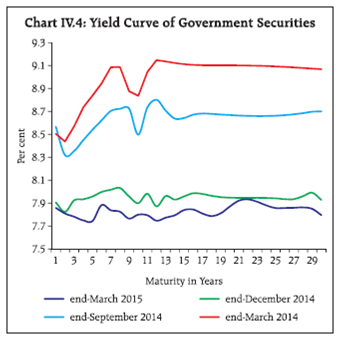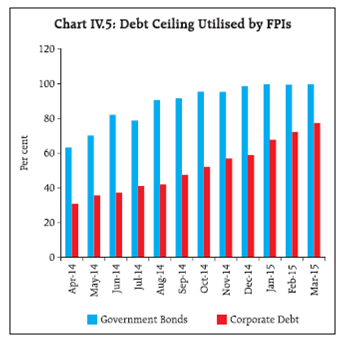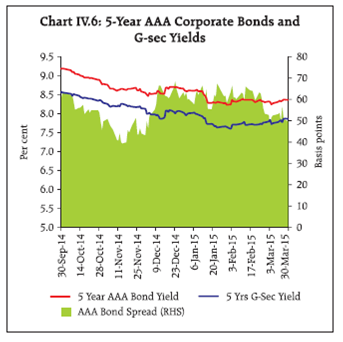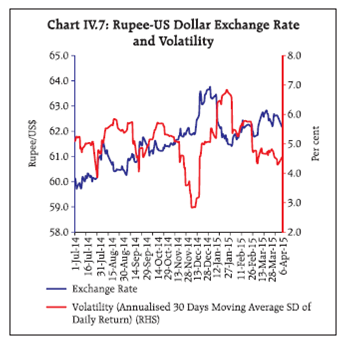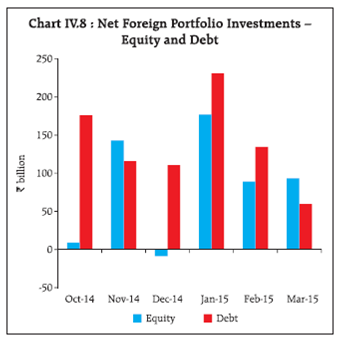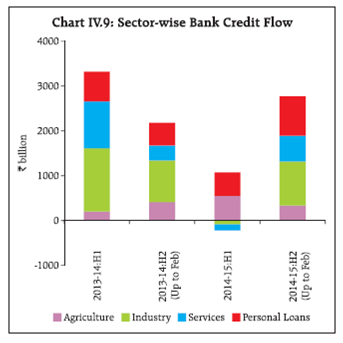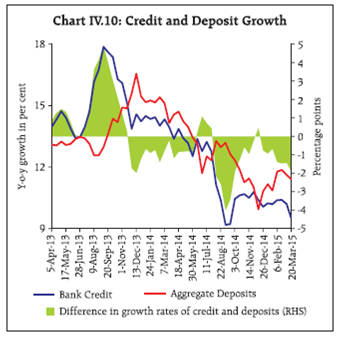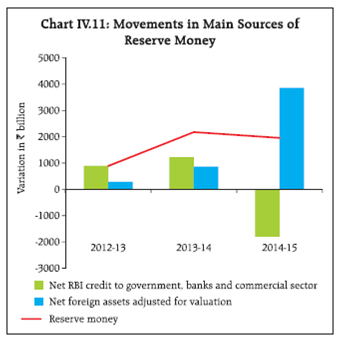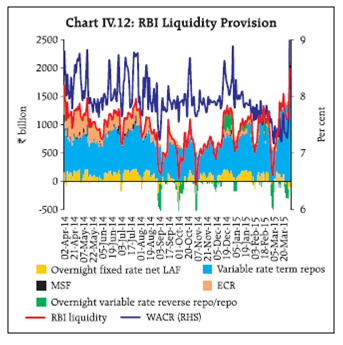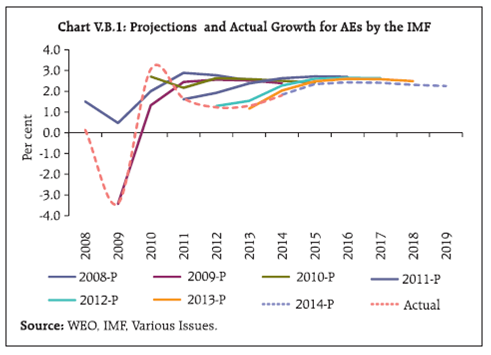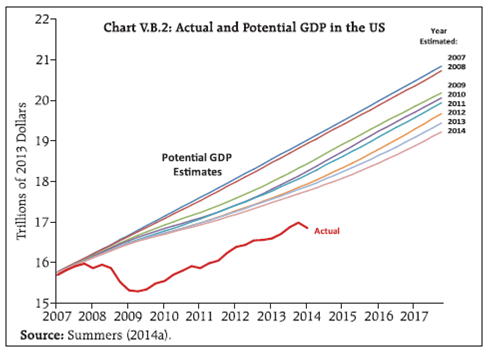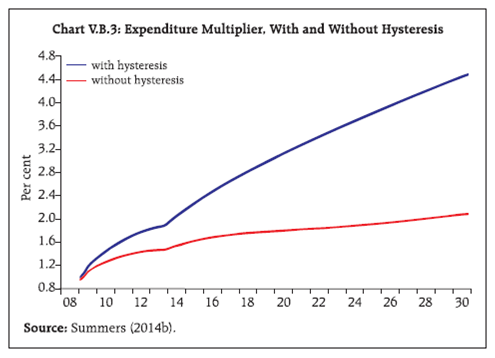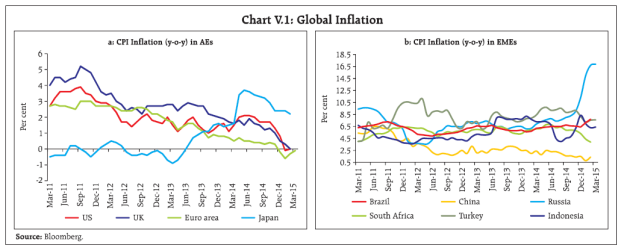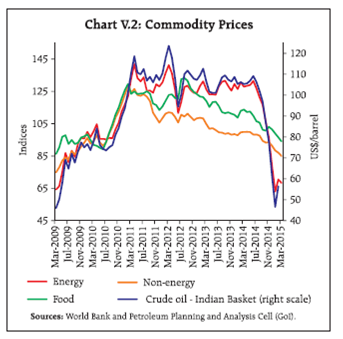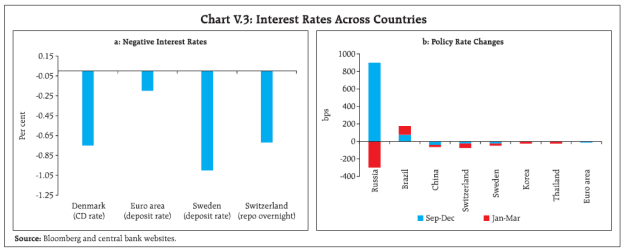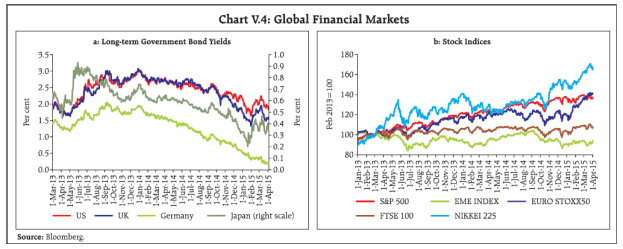 IST,
IST,
The Monetary Policy Report - April 2015
The broad-based decline in retail inflation since September 2014, plans announced in the Union Budget to step up infrastructure investment, depressed commodity prices and upbeat financial market conditions have improved the prospects for growth in 2015-16. Retail inflation is projected to remain below 6 per cent in 2015-16, within the target set for January 2016. Persisting slack in the economy and restrained input costs should sustain disinflationary impulses, unless disrupted by reversal in global commodity prices and/or deficiency in the south-west monsoon. Since the first Monetary Policy Report (MPR) of September 2014, tectonic shifts in the global and domestic environment drastically changed the initial conditions that had underpinned staff’s outlook at that time. The most significant shock to forecasts has been the collapse of international commodity prices, particularly those of crude1. For the Indian economy, this translated into a sizable softening of prices of both raw materials and intermediates. Their pass-through, given the persisting slack in economic activity, weakened pricing power and fed into a faster than anticipated easing of output price pressures. Another factor vitiating staff’s baseline assumptions has been the different speeds at which global activity evolved across geographies. With several emerging market economies (EMEs) slowing down alongside sluggish advanced economies – barring the United States (US) – external demand fell away and sent prices of tradables into contraction. For India, import prices declined faster than export prices, conferring unexpected gains in net terms of trade as well as an appreciable easing of imported inflationary pressures. As data from the US allayed fears of early monetary policy normalisation and ultra accommodative monetary policies took hold in Europe, Japan and China as also elsewhere, risk appetite roared into financial markets and India became a preferred destination for capital flows. The appreciating bias imparted to the exchange rate of the rupee brought with it a disinflation momentum. Domestically, prices of fruits and vegetables ebbed from September after supply disruptions induced spikes in July-August. Aided by proactive supply management strategies and moderation in the pace of increase in minimum support prices, food inflation eased more than expected2. Another favourable but unanticipated development that restrained cost-push pressures has been the sharp deceleration in rural wage growth to below 6 per cent by January 2015 from 16 per cent during April-October 20133. The confluence of these factors fortified the anti-inflationary stance of monetary policy and reinforced the impact of the policy rate increases effected between September 2013 to January 2014. In the event, CPI inflation4 retreated below the January 2015 target of 8 per cent by close to 300 basis points. Going forward, staff’s assessment of initial conditions and consequent revisions to forecasts in this MPR will be fundamentally shaped by these developments. The outlook will also likely be influenced by the new monetary policy framework put in place in February 2015, marking a watershed in India’s monetary history. The Government of India and the Reserve Bank have committed to an institutional architecture that accords primacy to price stability as an objective of monetary policy. The Monetary Policy Framework Agreement envisages the conduct of monetary policy around a nominal anchor numerically defined as below 6 per cent CPI inflation for 2015-16 (to be achieved by January 2016) and 4 +/- 2 per cent for all subsequent years, with the mid-point of this band, i.e., 4 per cent to be achieved by the end of 2017-18. Failure to achieve these targets for three consecutive quarters will trigger accountability mechanisms, including public statements by the Governor on reasons for deviation of inflation from its target, remedial actions and the time that will be taken to return inflation to the mid-point of the inflation target band. This flexible inflation targeting (FIT) framework greatly enhances the credibility and effectiveness of monetary policy, and particularly, the pursuit of the inflation targets that have been set. The commitment of the Government to this framework enhances credibility significantly since it indicates that the Government will do its part on the fiscal side and on supply constraints to reduce the burden on monetary policy in achieving price stability. Inflation expectations of various economic agents polled in forward looking surveys have been easing, partly reflecting the adaptation of expectations to the decline in inflation as well as growing credibility around the Reserve Bank’s inflation targets. Although households’ expectations of inflation three months ahead as well as one year ahead appear to have firmed up modestly in March 2015 in response to the uptick in retail inflation in January – February 2015, the softening of food and fuel inflation will likely temper those expectations going forward (Chart I.1 and Box I.1). This is borne out by the survey of professional forecasters for March 2015 in which five years ahead inflation expectations have dropped by 50 basis points to 5.3 per cent. Professional forecasters expect CPI inflation to average between 5.0 and 6.0 per cent in 2015-16 (Chart I.2). The industrial outlook survey of the Reserve Bank indicates that manufacturers expect softer input prices in the near-term, which could transmit to output prices with a lag in view of the slack in economic activity (Chart I.3). Box I.1: What is Driving Inflation Expectations? Understanding the dynamic interaction between inflation and inflation expectations is important for setting monetary policy. Inflation is sensitive to change in the output gap and inflation expectations, both of which monetary policy can influence by modulating aggregate demand. In countries where inflation expectations are well anchored, inflation has become less sensitive to variations in the output gap, leading to a flattening of the Phillips curve. In these countries, inflation has even become less sensitive to major supply shocks (Bernanke, 2007). Survey-based gauges of expectations tend to be somewhat backward-looking for the near term – responding to changes in actual inflation, Price movements of frequently bought food products have a significant bearing on inflation expectations. Fuel prices also move inflation expectations quickly: despite having lower weights in the consumption basket, their price changes get wide publicity in the media and influence expectations faster than their actual impact on the consumption basket. Longer-term expectations are typically more stable. Empirical analysis using data for the period September 2008 to December 2014 shows that 3 months ahead inflation expectations move largely in response to changes in prices of vegetables/fruits and petrol – which together explain almost 60 per cent of the change in inflation expectations. These findings are robust, i.e., even if the last quarter (October-December 2014) – when inflation expectations declined sharply – is excluded from the sample, the estimated coefficients remain stable. The experience of inflation targeting countries suggests that a credible monetary policy framework with clarity about the objective function of the central bank helps in anchoring inflation expectations. In the UK for example, just the announcement of instrument independence for the Bank of England in May 1997 led to an immediate fall in inflation expectations by 50 basis points along the entire term structure (Haldane, 2000). In this context, the Monetary Policy Framework Agreement in India should be able to reinforce the disinflationary forces currently at work and anchor inflation expectations around the medium-term inflation target. References: Bernanke, Ben S. (2007), “Inflation Expectations and Inflation Forecasting”, July 10, 2007. <http://www.federalreserve.gov/newsevents/speech/bernanke20070710a.htm> Haldane, Andrew (2000) “Targeting Inflation: The United Kingdom in Retrospect”, <https://www.imf.org/external/pubs/ft/seminar/2000/targets/strach7.pdf> Turning to inflation forecasts, large and unanticipated changes in initial conditions referred earlier warrant revised baseline assumptions (Table I.1). Updated estimates of structural models and information yielded by surveys and market-based gauges indicate that CPI inflation will remain below the target of 6 per cent set for January 2016, hovering around 5 per cent in the first half of 2015-16, and a little above 5.5 per cent in the second half (Chart I.4). Uncertainties surrounding commodity prices, monsoon and weather-related disturbances, volatility in prices of seasonal items and spillovers from external developments through exchange rate and asset price channels are reflected in a 70 per cent confidence interval of 3.7 per cent to 7.9 per cent around the baseline inflation projection of 5.8 per cent for Q4 of 2015-16. Medium-term projections derived from model estimates assuming an unchanged economic structure, fiscal consolidation in line with the recalibrated path, a normal monsoon and no major exogenous or policy shocks indicate that CPI inflation in 2016-17 could be around 5.0 per cent in Q4 of 2016-17, with risks evenly balanced around it. Real Gross Domestic Product (GDP) growth for 2014- 15 was projected by the Reserve Bank at 5.5 per cent. The CSO’s provisional estimates of GDP (base: 2004-05) tracked staff’s projected path well up to Q2 of 2014-15. The new GDP data (rebased to 2011-12) released by the Central Statistics Office (CSO) at the end of January 2015 and on February 9, however, came as a major surprise as it produced significantly higher growth at constant prices. The divergence between the new series and the old series in the pace of growth of the manufacturing sector has turned out to be stark; in particular, the robust expansion of manufacturing portrayed in the new series is not validated by subdued corporate sector performance in Q3 and still weak industrial production5. In the financial and real estate sub-sector, the high growth of 13.7 per cent at constant prices is not corroborated by the observed sluggishness in key underlying variables such as credit and deposit growth, housing prices, rent and most importantly, the subdued performance of real estate companies in terms of sales growth and earnings. Data revisions and their after-effects are not unique to India, but the magnitude of the gap in real GDP growth rates between the old and the new series for 2013-14 and 2014-15 has complicated the setting of monetary policy. Undoubtedly, the new GDP data embody better coverage and improved methodology as per international best practices. Yet these data cloud an accurate assessment of the state of the business cycle and the appropriate monetary policy stance; particularly, they render forecasting tenuous. Projections based on the new series are also handicapped by the lack of sufficient history in terms of backdated data amenable to modelling. The macroeconomic environment is expected to improve in 2015-16, with fiscal policy gearing to an investment-led growth strategy6 and monetary policy using available room for accommodation. Business conditions in Indian manufacturing assessed in the Reserve Bank’s Business Expectations Index (BEI) developed from its industrial outlook survey indicates that Q1 of 2015-16 may see some tempering of the improvement in the second half of 2014-15 (Chart I.5). This is corroborated by some of the surveys polled by other agencies (Table I.2). It is important to recognise though that most of these surveys were conducted before the presentation of the Union Budget and the easing of monetary policy on March 4. The Reserve Bank’s consumer confidence survey (CCS) points to growing consumer optimism since June 2014, reflecting purchasing power gains arising from lower inflation as well as improved perception of income, spending and employment growth (Chart I.6). Large declines in commodity prices and the benign inflation outlook for the near-term should provide a boost to growth (Box I.2). Nevertheless, there are downside risks to growth which could restrain growth prospects if they materialise. The ongoing downturn in the international commodity price cycle, which commenced in 2012, could reverse, given occasional signs of oil prices reviving ahead of global economic activity. In fact, the volatile geopolitical environment could even hasten the reversal. The consequent resurgence of inflation pressures could overwhelm the nascent conditions setting in for recovery. Risks to budgetary forecasts from tax shortfalls, subsidy overshoots and disinvestment under-realisation could impact the level of budgeted allocation for capital expenditure. Early warnings on the south-west monsoon, given the probability of about 50 per cent currently being assigned to an El Nino event, could dent the outlook for agriculture. Finally, if the decline in the gross saving as percentage of Gross National Disposable Income (GNDI) from 33 per cent in 2011-12 to 30 per cent in 2013-14 continues into the medium-term, it could tighten the financial constraint to growth unless productivity improves significantly. Box I.2: Decline in Oil Prices – Impact on Growth and Inflation For a large net importer of crude oil like India, the decline in crude prices since June 2014 by about 50 per cent is a favourable external shock. Going forward, this could work towards improving growth prospects and easing inflation pressures further. Crude prices could impact economic activity and inflation in India through several channels: (i) higher real incomes for consumers; (ii) lower input costs, boosting corporate profitability and inducing investment; (iii) lower current account deficit (CAD); and (iv) improved market sentiment. These favourable effects could, however, be offset by weak global demand. In India, a US$ 50 per barrel decline in oil prices (Indian basket) sustained over one year could give rise to higher real income equivalent of about 4 per cent of total private consumption demand and about 2.9 per cent of nominal GDP. Assuming 50 per cent pass-through to domestic prices of petroleum products, the real income gain could enhance aggregate consumption demand by about 2 per cent and output by more than 1 per cent. For the corporate sector in India, particularly non-oil producing firms (such as cement, electricity, iron and steel, chemicals, textiles and transportation), with more than 5 per cent of their total costs in the form of fuel, panel regressions show a statistically significant inverse relationship between profitability and oil prices. Model estimates suggest that for a 10 per cent decline in oil prices (under alternative assumptions of pass-through to CPI) output growth could improve in the range of 0.1-0.3 percentage points, while CPI inflation could decline by about 20-25 basis points below the baseline. A caveat is in order though. The estimates presented under the balance of risks in this Chapter may differ due to different dynamics captured in different models and varying assumptions on pass-through. For instance in India, the entire decline in crude prices was not fully passed on because of the increase in excise duty on petroleum products by the Government. This suggests that model-based estimates at best could be indicative rather than precise. Reference: World Bank (2015). “Global Economic Prospects”, January 2015. Growth projections combining these forward looking assessments and model-based forecasts, including time series forecasts such as autoregressive integrated moving average (ARIMA) and Bayesian vector auto regressions (BVAR), point to a gradual pick-up in growth. Quarterly projections relate to gross value added (GVA) at basic prices, because of more robust estimation relative to expenditure side GDP and also due to better clarity on key indicators that are used in the compilation of data by the CSO. Growth in GVA at basic prices for 2015-16 is projected at 7.8 per cent, with risks evenly balanced around this baseline forecast. Possible revision to CSO’s estimates for 2014-15 is a key risk to the forecast, with the revisions expected to be in the downward direction (please see Chapter III) and consequently an upside bias gets built in (Chart I.7)7. For 2016-17, real growth in GVA at basic prices is projected at 8.1 per cent, assuming gradual cyclical recovery on the back of a supportive policy environment, but without any policy induced structural change or any major supply shock. If the GDP growth for 2014-15 is revised down by the CSO, the trajectory will change accordingly. The Reserve Bank’s professional forecasters’ survey indicates an average GVA growth of 7.9 per cent for 2015-16 (Chart I.8 and Table I.3). The baseline paths projected for growth and inflation are subject to realisation of a set of underlying assumptions (Table I.1). The likely paths relative to the baseline that may evolve under plausible risk scenarios are set out below (Charts I.9 and I.10). (a) Sharp Increase in Crude Oil Prices Global crude oil prices are assumed to increase gradually over the forecast horizon in the baseline projections. There is, however, a non-trivial risk of a sharp increase in international crude prices triggered by the materialisation of geo-political tensions and other supply disruptions. In the event of such a shock pushing crude oil prices up by about US$ 15-20 per barrel above the baseline, inflation could be higher by about 40-60 basis points (bps) by the end of 2015-16 (on account of both direct and indirect effects). Growth could weaken by 10-30 bps over the next two years as the direct impact of higher input costs would be reinforced by spillover effects from lower world demand. (b) Below Normal Monsoon in 2015-16 As against the normal monsoon assumption in the baseline, there is a risk of monsoon turning out to be deficient in 2015. This could lead to a lower agriculture output which, in turn, would lower the overall GVA growth by around 40 bps in 2015-16. Food prices could consequently increase, leading to inflation rising above the baseline by 80-100 bps in 2015-16. Factors like spatial and temporal distribution of monsoon, policies relating to food stocks, procurement and minimum support prices (MSPs) may moderate or accentuate the impact of rainfall deficiency. (c) Depreciation of the Rupee Uncertainties surrounding the exchange rate persist. The key risk is that normalisation of monetary policy by the US Fed which may spark off safe haven capital flows into US treasuries and spur further appreciation of the US dollar. On the other hand, deflation risks in some of the advanced economies could warrant further monetary accommodation. A depreciation of the rupee by around 10 per cent, relative to the baseline assumption of the current level of exchange rates continuing, could raise inflation by around 20 -30 bps in 2015-16. On average, growth would be higher by about 10 bps in 2015-16 due to an improvement in the external trade balance while it could turn out to be marginally weaker in 2016-17, assuming tightness in financial conditions intensifying further on materialisation of risks in the external environment. (d) Easing of Food Inflation Headline inflation could also undershoot from the baseline if food inflation moderates by more than what is envisaged. This could be brought about by positive supply shocks, especially through improvements in the supply chain, reforms in market infrastructure and a step-up in investment in agriculture. In such a scenario, headline inflation may be lower by around 100 bps than the baseline by the end of 2015-16. (e) Crude Oil Price Declining Further If crude oil prices decline below the baseline by US$ 15-20 per barrel in the near-term as a result of excess supply conditions/low global demand in a stable geo-political environment, inflation could turn out to be 30-60 bps below the baseline by the end of 2015-16. Such a decline in crude prices would also raise GVA growth by 10-30 bps above the baseline in the next two years under different pass-through scenarios. (f) Revision in CSO’s GDP Estimates Considerable uncertainty surrounds the advance estimates of GDP growth for 2014-15 and information on real economic activity relating to Q4 is expected to be better captured in the revised estimates, which would be released around the end of May 2015. If GVA growth (at constant prices) gets revised downwards by 50 bps in the subsequent release(s), it would alter the assessment of demand conditions and a decline in the inflation trajectory for the medium-term by 10-30 bps could result. (g) Pick-up in Investment Demand If the boost to investment expenditure announced in the Union Budget for 2015-16 helps in crowding in private investment, and correspondingly, if investment demand picks up, GDP growth may turn out to be over 50 bps above the baseline in 2015-16. With augmentation of capacity but a still negative output gap, the impact of higher investment demand on inflation in 2015-16 could be minimal. The balance of risks and possible deviations of inflation and growth paths from their projected baselines warrant a careful appraisal of forward guidance, especially the underlying conditions that drive such guidance (Box I.3). The outlook for growth and inflation is informed by the assessment of macroeconomic and financial conditions presented in Chapters II to V. Barring unforeseen shocks, the near-term appears to be characterised by continuing slack in the economy. Fiscal consolidation intentions and weak rural consumption demand are likely to keep demand side risks to inflation contained. From the supply side, risks in the form of reversal in global commodity prices, uncertainty surrounding monsoon outcomes, and possible exchange market pressures arising from volatility in capital flows associated with US monetary policy normalisation would need to be monitored carefully and continuously, given the past experience with spillovers from taper talk. The room for accommodating supply shocks in the conduct of monetary policy remains limited, even as supporting the revival of investment demand assumes high importance. Box I.3: Forward Guidance under Uncertainty Forward guidance acquired prominence in the communication of monetary policy of central banks of both advanced and emerging economies after the global crisis, particularly on confronting the zero lower bound (ZLB) constraint. Traditionally, forward guidance before the global crisis used to be in the form of “forecast but do not promise”; but at ZLB it became a policy instrument – investment demand could be conditioned by expectations about the future path of short-term interest rates. Thus, forward guidance at ZLB potentially amplified the easing impact of unconventional monetary policy. The use of forward guidance as an instrument of policy in normal times shifts the burden of understanding risks and uncertainty primarily to central banks who, in turn, face the trade-off between “credibility” and “flexibility”. Four broad variants of forward guidance have been used by central banks in the post-crisis period: (a) qualitative guidance on the likely stance of policy without linking it to any explicit end date, threshold value of any goal variable or key parameters; (b) qualitative guidance linked to evolution of specific state variables; (c) calendar-based forward guidance specifying the exact period over which the same policy stance will prevail; and (d) outcome-based forward guidance linked to threshold values of state variables. While the first two variants are somewhat open-ended, the third is time-contingent and the last one is state-contingent. Time and state-contingent forward guidance provides greater certainty, but strong commitment may limit flexibility. Balance of risks assessments often assume specific identifiable risks and the manner in which these could be transmitted. Unanticipated risks and model errors, however, could make the evolution of inflation and growth paths quite different from either the baseline or the risk scenarios. Financial market frictions could complicate risk assessment further, especially if they are either not explicitly modelled or their dynamic interactions with the real economy are not captured properly in models. When benefits of commitment under forward guidance are assessed against benefits of changing the policy stance not fully consistent with the guidance, occasionally the latter may be preferred because of developments that were hard to anticipate at the time of giving the forward guidance. This has led to the view that forward guidance should be a tool that must be reserved for use only under the ZLB constraint: “...For the policy practitioner, uncertainty is not abstract, it is a daily preoccupation. Uncertainty and the policy errors it can foster must not only be embedded in our decision-making processes ex ante, they must be worn like an ill-fitting suit ex post, that is, with humility” (Poloz, 2014). In India, forward guidance has served the purpose of guiding market expectations around monitoring the sources of and risks to inflation. Given the uncertainties surrounding time varying output gap estimates, the evolution of exogenous factors driving the inflation process, global spillovers, and the nature, size and timing of measures undertaken by the Government to contain inflation, forward guidance has to be conditioned by incoming data. Reference: Poloz, Stephen S. (2014). “Integrating Uncertainty and Monetary Policy-Making: A Practitioner’s Perspective”, Bank of Canada Discussion Paper 2014-6. 1 As against the baseline of US$ 100 per barrel assumed for the Indian basket of crude in September 2014, the average price for October – March works out to about US$ 64 per barrel. 2 In the second half of 2014-15 so far, average food inflation fell by 340 basis points from 8.2 per cent in April-September 2014. 3 After the revision of rural wage series by the Labour Bureau in November 2013, wage growth rates are not strictly comparable, 4 Unless stated otherwise, CPI inflation refers to year-on-year changes in the all India Consumer Price Index (CPI) combined (rural and urban) or CPI-C (base 2012=100). 5 For higher growth rates resulting from steep upward revision in estimates for the private corporate sector, please see R Nagaraj (2015), “Seeds of Doubt on New GDP Numbers - Private Corporate Sector Overestimated?”, Economic and Political Weekly, Vol. L No.13, March 28. 6 Besides significantly higher allocation for infrastructure, other initiatives such as the National Investment and Infrastructure Fund, the proposal to set up power projects with all prior approvals before awarding them through transparent auctions to the private sector, efforts to improve doing business in India and easing the availability of coal through auctions should help in brightening the overall investment climate while also crowding in private investment. 7 Model-based projection for 2015-16 using old GDP (at factor cost) data yields output growth at 6.5 per cent, as against 7.8 per cent projected for GVA at basic prices. The trajectory of headline inflation in the second half of 2014-15 turned out to be substantially lower than staff ’s assessment set out in the MPR of September 2014, aided by a sharp fall in global commodity prices and domestic food inflation. Cost pressures eased with falling raw material prices and slowdown in wage growth. Three major developments that followed the first Monetary Policy Report (MPR) of September 2014 have dramatically altered the evolution of underlying price/ cost conditions. First, the pass-through of the 28 per cent plunge in international commodity prices1 into domestic food, fuel and services prices worked in conjunction with the disinflationary stance of monetary policy to bring down inflation to 5.4 per cent in February 2015. Second, the Central Statistics Office (CSO) unveiled data revisions relating to consumer price index (CPI) and national accounts in January-February 2015 that updated the base years/weighting schemes and also brought in methodological improvements to align with international best practices (Boxes II.1 and III.1). Going forward, these information upgrades will have a bearing on staff’s assessment of inflation formation and forecasts. Third, the Government of India and the Reserve Bank formalised a landmark agreement on the monetary policy framework alluded to in Chapter I. These institutional changes will condition the future path of inflation to which the Reserve Bank and the Government of India are committing, if fiscal targets are adhered to and administrative interventions in the formation of key prices, wages and interest rates are minimised. Box II.1: Revision of the Consumer Price Index (CPI) Beginning January 2015, the CSO revised the base year of the CPI to 2012 (from 2010=100). The weighting pattern of the revised series is based on the 2011- 12 Consumer Expenditure Survey (CES) of the National Sample Survey Office (NSSO), which is more representative and recent than the CES 2004-05 used for the old series (Table II.B.1). A number of methodological improvements have also been undertaken by the CSO in the new series, which include: i. weighting diagrams use the modified mixed reference period* (MMRP) data of CES 2011-12 as against a uniform reference period (URP) of 30 days used in the earlier series; ii. geometric mean of the price relatives with respect to base prices is used to compile elementary/item indices, instead of the arithmetic mean used in the old series, thereby reducing the impact of large discrete change in prices over different markets; iii. in case of items sold through the public distribution system (PDS), prices of items covered under the antyodaya anna yojana (AAY) have also been included in addition to those items covered by above poverty line (APL) and below poverty line (BPL) categories; and iv. the sample size for collection of house rent data has been doubled from 6,684 in the old series to 13,368 in the revised series. The MPR of September 2014 had noted that the receding of inflationary pressures, guided by the monetary policy stance set out in January 2014, halted in the first half of 2014-15. While fuel inflation and inflation excluding food and fuel underwent steady moderation, headline inflation was propped up by food inflation, which experienced bouts of weather-induced short-lived surges. In September, however, inflation eased by 140 basis points. From September to November, disinflation gathered momentum and turned out to be faster than initially anticipated under the combined influence of a large decline in global commodity prices, softening of prices of fruits and vegetables domestically, continuing slack in the economy and the favourable ‘base effect’ of higher inflation a year ago (Chart II.1). The role of this base effect in inflation outcomes during 2014-15 turned out to be non-trivial. Just as it shaped the rapid disinflation until November, its reversal from December produced an upturn, despite still benign international commodity prices and moderate domestic food and input prices. Sequential changes in headline inflation reflect the combined impact of month-on-month (m-o-m) changes in prices – which provide an indication of the speed at which prices are evolving – and base effects. The momentum of headline inflation has been weak through December-February, mostly due to the prices of non-durable goods, especially perishable food (Chart II.2a). M-o-M price changes embodied in a diffusion index also point to weak momemtum; however, broad-based price pressures persist across items within the CPI (Chart II.2b). Going forward, base effects are likely to exert a downward pull on headline inflation up to August 2015 (Chart II.3). The intra-year path of headline inflation in 2014-15 exhibited higher volatility than in past years, essentially reflecting the contributions of its constituents (Chart II.4). The contribution of the food category weighted by its share in the CPI underwent large variations – accounting for more than half of headline inflation in the first half of 2014-15, but declining to about a third in November before increasing to close to 60 per cent by February. By contrast, the contribution of the category excluding food and fuel has been relatively stable, with some decline in recent months. Within the food group, different drivers have propelled individual elements (Chart II.5a). For cereals, moderation in inflation is attributable to lower increases in MSPs in 2014-152, active supply management policies in the form of increased allocation under the public distribution system (PDS) as well as open market sales of wheat. Moreover, an index of prices of PDS items (rice, wheat and sugar) captured within the CPI shows that PDS prices have fallen significantly even as market prices of these items have risen (Chart II.5b). In the case of vegetables and fruits, prices declined faster than expected in response to policy actions to discourage stockpiling3. Sugar prices moderated in consonance with global prices. However, prices of protein-rich items (eggs, fish, meat, milk and pulses) exhibited downward rigidity, reflecting structural mismatches between demand and supply. In the absence of revisions in administered prices of coal and cooking gas, fuel group inflation declined during the year, but rose to 4.7 per cent in February, mainly on account of increase in firewood and electricity prices (Chart II.6). The still large under-recovery on account of kerosene and cooking gas impeded the pass-through of lower international prices to administered prices of these items. During April- December 2014, under-recoveries of oil marketing companies (OMCs) in respect of sale of kerosene and cooking gas accumulated to `562 billion, amounting to potential outgoes under subsidies in spite of the drastic fall in international prices. With the pass-through of monetary policy actions into the economy, inflation excluding food and fuel ebbed steadily during 2014-15, reaching 4.1 per cent in February (Chart II.7). The decline in housing inflation (rentals) has been pronounced in the new base series relative to the old series in part due to methodological improvements set out in Box II.1. Inflation in prices of services such as health, education and household services showed some moderation in recent months, reflecting the slowdown in wage growth. For the transport and communication sub-group, deflation has set in from January 2015 under the impact of a sharp decline in international crude oil prices which affected prices of fuels included in this subgroup. Between June 2014 and January 2015, crude oil prices (Indian basket, rupee terms) declined by around 55 per cent, with 90 per cent of this fall occurring during October to January. In response, retail prices of petrol softened. Diesel prices, on the other hand, were increased step-wise till August in order to eliminate under-recoveries of OMCs; thereafter, there was a reduction during October to January (Chart II.8). The decline in domestic pump prices, however, was much lower than the downward movement in international crude oil prices on account of increases in excise duty cumulatively by `7.75 per litre on petrol and by `6.50 on diesel starting November 2014. Global crude prices remained volatile during February-March, tracking geopolitical and other global supply side developments referred to earlier. Other Measures of Inflation All measures of inflation generally co-moved with the headline CPI inflation since the last MPR. The decline in inflation in terms of the wholesale price index (WPI), however, has been most significant with a contraction of 2.1 per cent in the month of February 2015 (Table II.1). Since the MPR of September 2014, cost-push pressures in the Indian economy have eased significantly. As shown in the foregoing section, external cost conditions associated with imports of commodities, particularly crude and petroleum products, have declined on a large scale. This is directly reflected in the drop in wholesale price inflation into negative territory. Domestically too, input cost pressures have been abating on a sustained basis since June. However, the existence of supply constraints in various sectors of the economy is impeding a fuller response of output prices to these developments. Input costs for both farm and industrial sectors have contracted since Q3 of 2014-15 (Chart II.9). Manufacturing firms participating in the Reserve Bank’s industrial outlook survey also indicated sizable declines in raw material costs, with the lowest cost pressures since the January-March 2010 round (Table II.2). They have also been reporting improvement in pass-through into selling prices, including in the January-March 2015 round. Purchasing managers’ surveys for both manufacturing and services corroborate these assessments – the narrowing of the gap between input and output prices is indicating weakening pricing power. Wage growth, another key determinant of costs, has been decelerating, albeit from high levels, across various sectors of the economy in recent years. The slowdown in rural wage growth has been particularly noteworthy. The Labour Bureau revised data on rural wages in November 2013 to incorporate a number of new occupations besides reclassification of the existing occupations. It estimates that average annual growth in rural wages was 5.5 per cent for all occupations (agricultural and non-agricultural) for male workers in January 2015, substantially lower than the annual average growth of 15 per cent during the six-year period (2007-13) reported in the old series (Chart II.10). The slowdown in wage growth has been more pronounced in the case of unskilled labourers, presumably reflecting catch-up of low-wage states, sustained decline in rural inflation and emphasis towards productive asset creation relative to employment in public schemes such as under the Mahatma Gandhi National Rural Employment Guarantee Act (MGNREGA). These developments suggest that high real wage growth without commensurate improvements in productivity is not sustainable. Unit labour costs4 in manufacturing and services have picked up recently after moderating since 2013 (Chart II.11a). There was also a rise in the share of labour cost in total output, especially for the manufacturing sector (Chart II.11b). The State of Aggregate Supply Assessments of price/cost conditions in the economy, juxtaposed with the results of empirical analysis, provide useful insights into the state of aggregate supply – the responsiveness of aggregate output to price changes. Several factors determine the behaviour of aggregate supply, including the time-varying price-setting behaviour of firms in response to changes in marginal cost; the nature of price-setting, whether backward-looking or more flexible; the way inflation expectations are formed; and random supply shocks5. In technical terms, while price-setting behaviour determines the slope of the aggregate supply curve, the formation of inflation expectations and the incidence of supply shocks can produce shifts in the aggregate supply curve. The empirical evidence suggests that the behaviour of aggregate supply has been changing in recent years even as inflation dynamics have been evolving into uncharted territory. Price-setting behaviour of firms is now reckoned as less backward-looking than before; also, the response of inflation to demand and supply shocks has declined. Internationally, this has led to a loose consensus around the view that the aggregate supply curve has flattened and is turning out to be less sensitive to price shocks6. What this implies in the context of conducting monetary policy is that every unit of disinflation is going to cost more in terms of the sacrifice of output to rein in that amount of inflation. Empirical evidence available in the Indian context suggests that the behaviour of aggregate supply has undergone a change during the post-global crisis period in a manner that is broadly consistent with the international experience, but with country-specific nuances. In particular, the responsiveness of retail inflation to changes in marginal costs has declined. Furthermore, the sacrifice ratio7 has increased markedly relative to the international evidence. This has implications for monetary policy: going forward, every unit of inflation lowered is going to mean larger output foregone, and the state of the economy is going to weigh on the choice. Every cloud has a silver lining though; unlocking stalled investments, bridging gaps in the availability of key inputs such as power, land, infrastructure and human skill, and rebuilding productivity and competitiveness will improve the supply response and sustain the disinflation currently underway. This scenario envisages monetary policy in a steering rather than interventionist role in its commitment to price stability as its primary objective. Finally, as regards the impact of shocks, exchange rate pass-through8 has declined significantly. On the other hand, domestic shocks such as a deficient monsoon leave progressively deeper imprints on retail inflation and increase the persistence of inflation expectations. 1 As measured by the IMF’s primary commodity price index. 2 Minimum support prices were increased by only 0-5 per cent for various crops in 2014-15. 3 These include delisting of fruits and vegetables from the Agriculture Produce Market Committee (APMC) Act; bringing onions and potatoes under the Essential Commodities Act; raising minimum export prices and augmented access to imports. 4 As measured by the ratio of staff cost to value of production. 5 Angeloni, I., J. Gali, L. Aucremanne, A. Levin, M. Ehrmann and F. Smets (2006). “New Evidence on Inflation Persistence and Price Stickiness in the Euro Area: Implications for Macro Modeling”, Journal of the European Economic Association, Vol. 4(2–3), pp. 562–574. 6 Mishkin, F. S. (2007). “Inflation Dynamics”, International Finance, Vol. 10(3), pp. 317–334 and Razin, A. and A. Binyamini, (2007) “Flattened Inflation-Output Trade-off and Enhanced Anti-Inflation Policy: Outcome of Globalization?”, NBER Working Paper, No. 13280. 7 The sacrifice ratio is defined as the cumulative output losses that an economy must endure to reduce average inflation, on a permanent basis, by one percentage point. 8 Exchange rate pass-through is defined as the degree of responsiveness of domestic prices to a unit change in the exchange rate. Domestic economic activity firmed up in 2014-15, spurred by a pick-up in manufacturing and services. Little definitive evidence, however, is available on a clear ‘break-out’ of economic activity. Key macroeconomic indicators, leading and coincident, point to the presence of considerable slack in the economy. Recent upgrades to the national accounts by the CSO indicate that a rebound in economic activity that started in 2013-14 has gathered pace in the second half of 2014-15. While these estimates have generated considerable public scrutiny and debate, there is a building optimism that an inflexion point in the economic cycle is approaching. As inflation retreats in an environment of macroeconomic and political stability, confidence in setting a double-digit growth trajectory for the Indian economy over the medium-term is flooding back. Unleashing of these growth impulses hinges around decisively cutting the Gordian knot of binding supply constraints, investments locked in stalled projects and shortfalls in the availability of key inputs such as power, land, infrastructure and human skill formation. Business sentiment is also buoyed by investor-friendly tax proposals, planned switches in public spending from subsidies to investment that crowd in private enterprise, structural reforms and the intention to continue fiscal consolidation announced in the Union Budget for 2015-16. Advance estimates of the CSO indicate that the growth of real GDP (market prices) picked up to 7.4 per cent in 2014-15 from 6.9 per cent a year ago (Table III.1). Although official data for Q4 of 2014-15 will be available only by May 2015, implicit in the advance estimates for the full year is a step-up in the momentum of growth in the last quarter of the year. Driving this quickening of activity, the weighted contribution of private final consumption expenditure is estimated to have risen to 4.1 per cent in 2014-15 from 3.6 per cent in 2013-14. Quarterly data suggest, however, that the growth of private final consumption expenditure slowed down considerably in Q3 of 2014-15; it would need to have grown by around 12 per cent in Q4 to match advance estimates of 7.1 per cent for the full year. Coincident and leading indicators of consumption, however, point to persisting fragility of private consumption demand. Indicators of rural demand like sales of tractors and two wheelers point to persisting weakness. Rural income appears to have been adversely affected by deficient monsoons and decelerating growth in rural wages. Overall weakness in consumption demand is also evident in the still depressed production of consumer goods and significant deceleration in corporate sales growth (Chart III.1). Government final consumption expenditure (which includes consumption expenditure of the centre, states, local bodies and autonomous bodies) rose by 10 per cent in 2014-15 as per the advance estimates, mainly on account of faster expenditure growth by the states1. The aggregate expenditure growth of the Centre, however, moderated. The increase in expenditure on subsidies was offset by a sharp cutback in plan revenue expenditure and aggregate capital expenditure in order to adhere to the budgeted deficit target. Austerity in respect of various categories of expenditure was also necessitated by the shortfall in non-debt capital receipts and sluggish indirect tax collections. Non-tax revenues, however, exceeded the budgetary targets due to higher receipts on account of dividends and profits (Table III.2). Disinvestment receipts were less than half the budgeted amount in 2014-15. The Union Budget 2015-16 has provided for higher allocations to infrastructure and a substantial increase in the resource transfer to states, keeping in view the two-fold objectives of promoting inclusive growth and strengthening fiscal federalism. This has necessitated a deviation from the fiscal consolidation trajectory in 2015-16 and an extension of the period of convergence to the 3 per cent target for the gross fiscal deficit (GFD) as a proportion to GDP by one year. The budgeted reduction in GFD in 2015-16 reflects the combined impact of a compression in plan revenue expenditure and an increase in non-debt capital receipts. The CSO’s advance estimates of gradual pick-up in the growth of gross fixed capital formation in 2014-15 do not appear to be supported by its quarterly estimates which indicate deceleration in Q2 and Q3 (Table III.1). Although production of capital goods and non-oil nongold imports gathered some momentum in Q4, a big push in investment is essential for the economy to break out of the vicious cycle of supply constraints, stranded investments, stressed bank balance sheets, risk aversion and weak demand (Chart III.2). Progress on speedier project clearances is, however, yet to materalise (Chart III.3). The gross domestic saving rate in the economy has declined sharply over the last two years. The decline was on account of lower savings in physical assets by the household sector, mainly construction (Chart III.4). The contribution of net exports to overall GDP growth turned negative since Q2 on contraction in exports and some pick-up in imports. Exports shrank in Q3 on weak global demand and the sharp fall in international crude oil prices which affected exports of petroleum products (POL) [accounting for around 19 per cent of total merchandise exports]. Non-oil exports also added to overall contraction as price realisation declined considerably with the fall in international commodity prices (Chart III.5). With imports growing at a modest pace, the trade deficit widened in Q3 of 2014-15, though it was partly offset by improved net services exports (Chart III.6). During January and February 2015, the faster decline in imports relative to exports significantly reduced the trade deficit. Net services exports during January 2015 were, however, lower than in the preceding month as well as a year ago. In the financial account of India’s balance of payments, capital flows remained strong during Q3. Though equity flows weakened during the quarter, it was more than offset by the large accretion under banking capital as banks liquidated their overseas foreign currency assets. In Q4, the improved investment climate revived portfolio and foreign direct investment, which dominated net capital flows. Portfolio investment flows rose sharply to US$ 13.6 billion during Q4 from a relatively subdued level of about US$ 6 billion in the preceding quarter. A surge was evident in equity as well as debt investment by foreign institutional investors (FIIs). Similarly, foreign direct investment rose to US$ 5.5 billion during January 2015, more than twice the monthly average in the preceding quarter. With net capital flows being significantly larger than the external financing requirement, foreign exchange reserves rose to a peak level of US$ 343.0 billion by April 03, 2015. In terms of traditional metrics of foreign exchange reserve adequacy – import cover and the Greenspan- Guidotti rule for short-term debt cover – India has exhibited steady improvement. The import cover of reserves went up to 8.1 months at end-December 2014 from 7.8 months at end-March 2014 while the ratio of short-term debt to reserves improved to 26.7 per cent at end-December 2014 from 30.1 per cent at end- March 2014 (Table III.3). Further, net forward purchases of US$ 5.6 billion and bilateral swap arrangements with Japan and among the BRICS provide additional cover against external shocks. The CSO’s new series of national accounts aligns with internationally recognised best standards in terms of the United Nations’ Systems of National Accounts (SNA, 2008) and also improves data coverage. Output measured by gross value added (GVA) at basic prices is, however, in dissonance with various metrics tracked as either coincident or leading indicators in terms of both level and growth rates (Box III.1). In particular, the conventional indicators of corporate performance that are used to reflect movements in output and Per cent which closely tracked the series in the old base, have disconnected from the new series even after accounting for the differences between the ‘establishment approach’ (old series) and ‘enterprise approach’ (new series). From the supply side, agricultural activity slowed down through 2014-15, as the delayed onset of southwest monsoon, its uneven distribution and deficiency– especially in the early part of the season–affected kharif crops. GDP from agriculture and allied activities contracted by 0.4 per cent in Q3 (Table III.4). Initial expectations that the shortfall in the kharif harvest may be compensated by rabi crops did not materialise due to inadequate replenishing of soil moisture and reservoirs by Q3 and Q4, aggravated by a deficient and unevenly distributed north-east monsoon. Reflecting these factors, the second advance estimates of the Ministry of Agriculture indicate that the production of foodgrains declined by 3.2 per cent, and oilseeds by 8.9 per cent in 2014-15. Within foodgrains, the production of rice declined by 3.4 per cent and pulses by 6.8 per cent. Furthermore, unseasonal rains and hailstorms in early March are likely to affect agriculture production adversely. Even though the performance of allied activities is expected to remain stable, it remains to be seen whether they can compensate for the shortfall in agricultural production. The industrial sector shrugged off stagnation and grew for the second consecutive year in 2014-15. An analysis of the quarterly data, however, suggests deceleration in growth of mining and quarrying and manufacturing. This implies that the industrial sector would have to have grown by about 9 per cent and manufacturing by around 11 per cent in Q4 to meet the CSO’s projections for 2014-15 as a whole, which looks ambitious on the basis of information available so far. Core industries, which supply crucial inputs to other industries and have a weight of nearly 38 per cent in the index of industrial production (IIP), have been decelerating since December 2014, underlining the weakness in the growth drivers. Structural constraints have led to persistent declines in the production of core industries such as steel, natural gas, crude oil and fertilizers. The contraction in mining and quarrying and slowdown in electricity generation in the IIP highlight these constraints. As per the use-based classification, the growth in industrial production was driven by basic goods and capital goods. Lumpy and fluctuating capital goods production imparted volatility to industrial production. As discussed earlier in the chapter, the slowdown in consumer goods points to weak demand reflected in private final consumption expenditure. The revival in overall growth in 2014-15 hinged primarily around the services sector, which is estimated to have grown by 9.8 per cent. Quarterly analysis suggests that growth picked up steam from Q2 and strengthened further in Q3 led by ‘financial, real estate and professional services’ and ‘public administration and defence’. However, in an environment of deceleration in bank credit and deposit growth, coupled with stagnation in the real estate sector and slowdown in demand for professional services, the high growth of the ‘financial, real estate and professional services’ appears puzzling. Given the centre and state governments’ resolve on fiscal consolidation, the ‘public administration and defence’ services may not serve as a durable growth driver, going forward. Box III.1: New Series of National Accounts The National Statistical Commission (NSC) had recommended a change in base year for all key economic data every five years to account for structural changes in the economy. In line with this recommendation, the base year for national accounts in India was recently revised to 2011-12 (from 2004-05 earlier), as the year 2009-10 was not considered a normal year in view of the global financial crisis. In the new series, GDP at market prices – instead of GDP at factor cost - is the headline number reported as a measure of economic activity in line with international practices. Furthermore, ‘Gross Value Added (GVA) at basic prices’ – instead of GDP at factor cost – is the headline measure of activity from the supply side. Other changes in the series include, inter alia, comprehensive coverage of the corporate sector in both manufacturing and services as per the database available in the e-governance initiative viz. MCA-21 of the Ministry of Corporate Affairs (MCA), improved coverage of rural and urban local bodies, and incorporation of recent National Sample Surveys (NSS). Consequent upon these changes, nominal levels of GDP on the new base are lower relative to the old base. Growth rates of both nominal and real GDP on the new base are higher for each year. In terms of commonly used indicators of productivity – the incremental capital output ratio (ICOR) – the new series reveals a significant improvement, but this is not corroborated by the behaviour of other indicators, especially in an environment characterized by declining national savings, investment and general concerns about stalled projects (Chart a). In the manufacturing sector, GVA growth is much higher in the new series than in the earlier series. The growth of this sector appears to have been driven by the unorganised sector, which grew by 23.3 per cent in 2012-13. Data for subsequent year, however, suggests a slowdown of the unorganised sector, with manufacturing growth driven mainly by the organised sector (Table III.B.1). While the use of MCA-21 database could explain differences up to 2013-14, the advance estimates for 2014-15 have used corporate sector data – from the Reserve Bank of India (RBI) and the Bombay Stock Exchange (BSE) – in four key components of GDP, namely manufacturing, trade, hotels and restaurant, and real estate. An analysis of sequential flow of information on corporate earnings for Q3 of 2014-15 indicates that earnings growth has been much weaker than what is implied in the new series (Chart b). Services tax collection has also remained weak. A high growth of 13.7 per cent (at constant prices) in “financial, real estate and business services” reflects a possible upward bias in estimation. It is expected that the revised estimates for 2014-15 to be released by end-May 2015 will incorporate better information covering the second half of the year and provide greater clarity on the state of economic activity at the aggregate level. Uncertainty about the true value of macroeconomic variables is a formidable challenge for policy-making, particularly when data revisions result in information on the same variable for the same year computed at different times conveying different trends. The recent revisions in national accounts pose a challenge in terms of assessing the state of the business cycle and the position at which the economy is poised on it. Key to the setting of policies that modulate aggregate demand is a good ‘fix’ on the level of output relative to the economy’s potential. Estimating potential output from historical data is difficult even in the best of times. It has become much more complex in the aftermath of the global financial crisis when potential output across the world is likely to have fallen, led by decline in productivity. The critical issue is: do recent revisions to India’s national accounts capture this phenomenon? Empirical assessment suggests that overestimation of potential output can be costly, in terms of greater macroeconomic volatility and/or an acceleration of inflation getting entrenched (IMF, 2011)2. A production function approach to estimating potential output indicates a sharp decline in the contribution of total factor productivity to potential output. Various time series estimates of potential output – without imposing any a priori judgment relating to the structural interpretation of the new GVA series – suggest that in terms of levels, the output gap has remained negative since 2012-13, although the gap is gradually closing (Box III.2). The latest round of the Order Books, Inventory and Capacity Utilisation Survey (OBICUS) of the Reserve Bank reveals that capacity utilisation (CU) remained range-bound in Q3 of 2014-15 as compared to the previous quarter and declined over its level a year ago (Chart III.7). An overall assessment of the state of the real economy points to recovery gaining ground slowly. Significant slack and structural rigidities continue to hold back a sharp revival in investment demand. Lack of certainty about cash flows from new investment projects is contributing to the lacklustre investment cycle. Unless structural reforms unleash productivity gains going forward, lower saving and investment rates could become a risk to stronger recovery. Recent reform measures in the infrastructure sector, including target-based progress on national highways, encouraging FDI in railways and defence, plans to start power plants in the private sector with all approvals in place, bringing in the requisite amendments in the Land Acquisition Act to expedite project clearances and coal block auctions are expected to address infrastructure bottlenecks and boost medium term growth prospects. Empirical estimates of the output gap at the aggregate level and indicator/survey based information for major sectors of the economy can provide an assessment of slack in the economy. Potential output3, however, is difficult to measure and is subject to estimation errors. The recent revision in national accounts data which shows major level differences in old and new series (at constant prices) for the last four years (2011-12 to 2014-15) imparts further complexity to the estimation, given the lack of data for previous years under the new series. In the absence of high-frequency and regularly updated data on capital stock and labour in the Indian context, estimates of potential growth through a structural production function approach can, at best, be regarded as indicative rather than definitive, with the results suggesting a sharp decline in the contribution of total factor productivity, as set out earlier. A useful alternative to the production function approach is to use time series methods that can estimate potential output solely from information contained in the past data, however short their history may be. Use of various univariate filtering techniques such as Hodrick-Prescott (HP) and Kalman filters, and a multivariate filter constructed from spliced quarterly GVA series, indicate that the output gap (i.e., actual output minus potential output) has been negative since 2012-13, irrespective of the technique (Chart a). 1 The growth in revenue expenditure of the states at the consolidated level was budgeted to grow by 20.5 per cent in 2014-15 (BE). 2 International Monetary Fund (2011). World Economic Outlook, Chapter 1, April. 3 Potential output is generally defined as the full capacity level of output or sustainable level of output in which the intensity of resource use is non-inflationary. While potential growth is the growth in the potential output, the output gap is the deviation of actual output from its potential level and is expressed as a percentage of potential output. IV. Financial Markets and Liquidity Conditions Amidst abundant global liquidity and risk-on risk-off fluctuations in investor appetite, financial markets in India rallied strongly in the second half of 2014-15, supported by improvement in domestic macroeconomic conditions. Liquidity was comfortable in all segments and this was reflected in a pick-up in turnover, softening of interest rates, an appreciating bias in the exchange rate of the rupee and equity markets scaling historic highs. Since the MPR of September 2014, domestic financial markets have been buoyed through Q3 and Q4 of 2014-15 by the global search for yields as fears of imminent normalisation of US monetary policy receded and ultra-accommodative monetary easing commenced in the euro area and Japan. Barring sporadic volatility sparked by incoming data, India became a preferred destination in portfolio reallocations, with discernible differentiation vis-à-vis other EMEs. Liquidity conditions were expansionary in all segments, spurring trading activity. In the money markets, interest rates eased during Q3, barring intermittent spikes around the third week of October due to festival-related pick-up in currency demand, and again in the second half of December on account of advance tax payments and quarter-end balance sheet adjustments. The shift in the monetary policy stance steered by two cuts in the policy repo rate enabled interest rates to ease further during Q4. Pro-active liquidity management under the new operating procedure of monetary policy has played a key role in the seamless transmission of policy impulses through the money markets. There has also been a marked ebbing of daily volatility measured through generalised autoregressive conditional heteroskedasticity (GARCH), although these estimates for the end of 2014-15 tend to be strongly influenced by the year-end spike in call rates (Chart IV.1). In this context, the Agreement on the Monetary Policy Framework enjoins the Reserve Bank to set out in the public domain the operating target and procedure of monetary policy and any changes therein that are effected from time to time (Box IV.1). Other money market segments moved in consonance with the call money market. With the steady migration of activity to collateralised segments, viz., collateralised borrowing and lending obligation (CBLO) and market repo, call money volumes have thinned, currently accounting for about 10-11 per cent of the total overnight volume (Chart IV.2). This reflects preference for collateralised funding as well as improvements in the microstructure such as co-terminus settlement of market repo and outright trade in Government securities. Trading in the call money market tends to be skewed by its microstructure – over 70 per cent of the activity is concentrated in the opening hour and closing hour of trading; top five borrowers accounting for about 50 per cent of total daily call volumes on average (Chart IV.3). These features have occasionally accentuated volatility in the call money market, particularly in Q4. Box IV.1: Operating Target and Operating Procedure of Monetary Policy The Policy Rate The fixed overnight repurchase (repo) rate under the Liquidity Adjustment Facility (LAF) is the single monetary policy rate. The Operating Target of Monetary Policy The weighted average call money rate (WACR) is the operating target of monetary policy. The Operating Procedure of Monetary Policy Once the policy rate is announced in the Bank’s statements on monetary policy, the operating procedure aims at modulating liquidity conditions so as to achieve the operating target, i.e., to anchor the WACR around the policy rate. This is the first leg of monetary policy transmission to the financial system and the economy. Liquidity Management Pro-active liquidity management is the mechanism through which the operating target is achieved. The main features of the revised liquidity management framework announced on August 22, 2014 and implemented since September 5 are as follows: (i) assured access to central bank liquidity of one per cent of banks’ net demand and time liabilities (NDTL) comprising 0.25 per cent of NDTL provided through overnight fixed rate repo auctions conducted daily at the policy rate, and 0.75 per cent of NDTL provided through 14-day variable rate term repo auctions conducted on every Tuesday and Friday; (ii) fine-tuning operations through variable rate repo/reverse repo auctions of maturities ranging from overnight to 28 days to even out frictional liquidity mismatches that occur in spite of assured liquidity operations; and (iii) outright open market operations through auctions and anonymous screen-based trading on the Negotiated Dealing System- Order Matching (NDS-OM) platform to manage enduring liquidity mismatches. Special operations are also conducted on holidays to help market participants tide over pressures emanating from one-off events such as tax payments, government spending, balance sheet adjustments and payment and settlement requirements. Standing Facilities A Marginal Standing Facility (MSF) allows market participants to access central bank liquidity at the end of the day (including Saturdays) over and above regular and fine-tuning operations by using up to 2 per cent of their stipulated Statutory Liquidity Ratio (SLR) holdings of government securities in addition to excess SLR as collateral at a rate set at 100 basis points above the policy rate. Fixed rate daily overnight reverse repo auctions are conducted at the end of the day (including Saturdays) to allow market participants to place surplus liquidity with the Reserve Bank at a rate set at 100 basis points below the policy rate. The fixed rate daily overnight reverse repo operates as a de facto standing facility. The MSF rate and the fixed overnight reverse repo rate define an informal corridor for limiting intra-day variations in the call rate. The market for commercial paper (CPs) picked up momentum during Q3 and Q4 (up to March 15), with issuances of CPs growing y-o-y by 25 per cent and 49 per cent, respectively. This reflected some substitution of short-term bank credit due to tight bank lending conditions. The weighted average discount rate of CPs softened from 8.9 per cent during the second half of September 2014 to 8.5 per cent in the second half of January 2015, before hardening to 8.8 per cent in the first half of March 2015. In the Government securities (G-sec) market, yields softened through Q3, barring some spikes during the second half of December 2014 due to the Ukrainian crisis followed by the Russian currency crisis. Buoyant investor sentiment conditioned by the ongoing disinflation in India and expectations of monetary policy easing helped the market to shrug off the impact of the Federal Reserve completely exiting quantitative easing (QE) in October. The OPEC’s decision in November 2014 not to cut production strengthened market sentiment and reinforced the decline in G-sec yields. During the global sell-off triggered by the depreciation of the Ruble, however, the 10-year generic yield jumped by 15 basis points on December 16 – the largest increase on any single day during the second half of 2014-15. As the Russian currency crisis abated, G-sec yields declined in Q4, aided by the softness in international crude oil prices, fall in US treasury yields and resumption of flows into the domestic foreign exchange market. G-sec yields hardened transiently in response to the reduction in the SLR in February and the broadly unchanged size of the market borrowing programme announced in the Union Budget. As in the past, recourse to Treasury Bill auctions in February and March, notwithstanding large redemptions, inverted the G-sec yield curve, reflecting the reluctance of market participants to part with liquidity as the balance sheet date approached. Barring these episodes, the G-sec market was rangebound during Q3 and Q4 with a downward shift in the yield curve (Chart IV.4). The 10- year yield declined by 72 basis points from 8.52 per cent at the end of September 2014 to 7.80 per cent on March 31, 2015. Foreign portfolio investors’ (FPIs) investment in G-secs stood at `1,529 billion as on March 31, 2015. With the exhaustion of the limit for investment in G-secs (US$ 30 billion), FPIs invested in debt mutual funds allowed under the limit of US$ 51 billion for investment in corporate debt, indirectly expanding their investment in G-secs (Chart IV.5). Activity in the corporate bond market also gathered pace in Q3 and Q4, driven by private placements which recorded a y-o-y growth of 112 per cent. On the other hand, amounts mobilised through public issues declined through this period (up to February). The significant increase in resource mobilisation through corporate bonds could be reflecting substitution effects since bank credit growth has remained subdued in conjunction with tight credit conditions. FPIs’ investment in corporate bonds stood at `1,890 billion as on March 31, 2015, accounting for 77 per cent of the limit, and as a consequence, secondary market trading volumes surged by 51 per cent (y-o-y) in the second half of 2014-15. Yields of AAA rated corporate bonds generally moved in tandem with G-sec yields, but hardened somewhat in March (Chart IV.6). Notwithstanding increased resource mobilisation through corporate bonds and CPs, the flow of financial resources to the commercial sector remained lower during 2014-15 than a year ago, mainly due to the deceleration in non-food credit. In the foreign exchange market, the predominant driver has been robust capital flows that started from March 2014. The exchange rate of the rupee moved in a narrow range of `61.04 - 62.14 per US$ but with an upward bias through most of Q3. From December 10, however, the rupee experienced downward pressures, slipping to a recent low of `63.75 on December 30 on a combination of factors – spillovers from the Russian currency crisis; month-end purchases by oil marketing companies; profit booking by FPIs; weak readings on industrial output, and the relentless strengthening of the US dollar. By the second week of January 2015, volatility in the spot market ebbed and the rupee resumed trading with an appreciating bias on the resumption of FPI flows, abating of the Russian currency crisis and a sharp fall in the trade deficit (Chart IV.7). The ECB’s announcement of QE on January 22 and sustained softening of international crude oil prices added to the positive sentiment in the exchange market. In the second week of February 2015, incoming strong US non-farm payroll data set off a slide across emerging markets’ currency and equity markets. Range-bound trading with modest gains followed the dovish comments from the Federal Reserve in March regarding the timeframe for raising its policy rate. In real effective terms, the rupee appreciated over its level at the end of March 2014 on account of persisting inflation differentials vis-à-vis trading partners (Table IV.1). The forward market also exhibited heightened activity in Q3, with the six-month forward premium declining from 8.16 per cent on October 9 to 7.13 per cent on December 26. In Q4, however, the forward premia hardened somewhat from the second half of February on increasing demand. Barring soft patches, equity markets rallied through the second half of 2014-15, scaling all-time highs. Indian indices were among the better performing in the world, with significantly attractive valuations relative to fundamentals and the cross-country EME experience. Some of these gains were pared during December 2014 by pessimism triggered by fears of earlier than expected reversal in the US interest rate cycle, uncertainty relating to Greece and geo-political tensions in the Ukraine and the Middle East. Equity markets, however, started gaining again from the beginning of January 2015 on resumption of portfolio investment flows (Chart IV.8). Buoyant sentiment bounced back with the Reserve Bank’s announcement of a cut in the policy repo rate on January 15, and the BSE Sensex reached a historic high closing at 29,682 on January 29, 2015. In the early part of February, equity markets gave up some gains on concerns following the results of Delhi elections, weak results reported by some big corporates, poor Chinese trade data and decline in European stocks. In the second half of the month, however, equity markets recovered and gained strength with the announcement of the Union Budget 2015-16 as also passing of key legislations relating to coal, mining and insurance susequently. During March 2015, the stock market eased moderately on global cues. In the primary market, Qualified Institutional Placement (QIP) was moderate at `41 billion while equity and debt issues declined to `34 billion during Q3. On the other hand, private placements of corporate bonds and mutual funds spurted to `1,240 billion and `574 billion, respectively. There has already been some improvement in resource mobilisation in Q4 in response to investment-friendly measures announced in the Union Budget 2015-16 and steps taken by the SEBI to streamline existing regulations relating to public shareholding of state-owned companies. In the credit market, subdued activity in the first half of the year picked up from Q3 as banks shifted their portfolios towards retail lending, especially housing. Credit flow to the industrial sector – particularly to food processing and basic metals – and services, also improved modestly (Chart IV.9). Reflecting the generally sluggish demand for credit as also regulatory requirements relating to the liquidity coverage ratio (LCR), banks’ investments in G-secs, on the other hand, showed a sharp increase during 2014-15. Excess SLR holdings of banks increased significantly as a consequence. Banks have been rebalancing their lending portfolio away from sectors in which their assets are under stress to relatively stress free sectors such as retail housing and automobiles. Following the 50 basis points reduction in the policy rate in Q4, 22 banks have reduced their median term deposit rates in the range of 7-53 bps while 14 banks reduced their base rates in the range of 10-50 bps. Broad money (M3) growth remained low during Q3 and Q4. With credit and deposit growth moving broadly in tandem, liquidity conditions in the system remained comfortable throughout, barring transient liquidity mismatches due to frictional factors alluded to earlier (Chart IV.10). Currency demand started picking up since Q3 with the festival season and drained some liquidity, but timely liquidity provision by the Reserve Bank smoothened these short-lived spikes. The provision of primary liquidity was augmented by the large expansion in net foreign assets of the Reserve Bank. Active sterilisation operations, however, contained the growth of reserve money (Chart IV.11). Liquidity conditions improved during Q3 of 2014-15, reflecting a confluence of structural and frictional factors, barring temporary pressures around festival days, mid-December advance tax payments and quarterend window dressing. In Q4, liquidity conditions tightened since the second week of January 2015 with cutbacks in government spending, pick-up in credit demand and seasonal increase in currency demand. The Reserve Bank’s pro-active liquidity management operations ensured that the call rates stayed range bound around the policy rate, reducing day-to-day volatility (Chart IV.12). In pursuance of the Dr. Urjit R. Patel Committee’s recommendation to move away from sector-specific refinance, the export credit refinance (ECR) limit was reduced in three phases starting June 2014 and finally subsumed in the provision of system level liquidity with effect from February 7, 2015. As a further measure to facilitate smoother operations, the Reserve Bank started conducting reverse repo and MSF operations on all Saturdays, effective February 21, 2015. Overall, financial markets traded on a bullish note during the second half of 2014-15 against the backdrop of improved domestic fundamentals and a global appetite for risk. The evolution of overall global liquidity conditions has been conditioned by expectations relating to high intensity events such as the lift-off of US interest rates, monetary accommodation elsewhere and geo-political flashpoints. Liquidity conditions remained stable and movements in the overnight call money rate were, by and large, anchored around the policy repo rate. Global economic recovery remained tepid and divergent across economies, with most EMEs experiencing slowdown. While AEs remain susceptible to the risk of deflation, inflationary pressures subsided in key EMEs giving leeway for easing monetary policy. Global commodity prices continue to decline. Financial markets were buoyant but volatile in pricing in policy developments in major economies. In the months following the MPR of September 2014, global economic activity appears to be stabilising, but with markedly divergent growth profiles between advanced and emerging economies, and between commodity exporters and importers. The collapse of international commodity prices, especially of crude oil, seems to have reallocated demand across economies. Monetary policy stances across countries have been easing, including unconventionally, and market expectations on the timing of the US monetary policy normalisation have been pushed back. In response, there have been large movements in exchange rates and other asset prices. Reflecting risk appetite and search for yield, long-term yields have fallen to record lows amidst heightened volatility in financial markets. For commodity exporters, however, risk spreads have widened and currency depreciations have been sizable. Thus, even though financial conditions are easy and are being reflected in financial asset prices, the outlook for global growth remains moderate, held back by still-weak demand. V.1. Global Economic Conditions In the United States, growth has been firming up, aided by improving labour and housing market conditions. The sharp appreciation in the US dollar in recent months could, however, dampen prospects for exports. In the Euro area, economic conditions remain weak although some pick-up in Q4 of 2014 and the early months of 2015 is being observed, supported by lower crude prices and the depreciation in the euro as well as increased bank lending. The contraction of activity in Japan moderated in the final quarter of 2014, with mixed signals from higher frequency data in the beginning of 2015 - consumer confidence and exports show improvement, but retail sales and industrial production have contracted. Most EMEs continue to decelerate due to subdued external demand, political uncertainties and domestic supply-side constraints. In China, activity has slowed over the second half of 2014 and Q1 of 2015 as investment demand lost pace and the real estate sector weakened on deleveraging and financial repair among households and corporations. The Russian economy slowed sharply due to falling oil prices and Western sanctions. Contraction continues in Brazil as high inflation squeezes domestic demand. Falling oil and commodity prices also weighed on growth prospects of countries in the Middle East, Eastern Europe and Latin America (Table V.1). Overall, although the near-term outlook is improving slowly, AEs are yet to fully recover from the aftereffects of the global financial crisis. EMEs face the challenge of addressing persistent negative output gaps and falling growth potential, which yields a more subdued near-term outlook for them. In fact, the sluggish global recovery over the course of 2014 and 2015 so far has warranted successive downward adjustments to forecasts the world over, raising concerns of ‘secular stagnation’ (Box V.I). Box V.1: Secular Stagnation: A Post-crisis Concern Despite ultra accommodative monetary policies pursued for a considerable period, AEs continue to languish, raising fears that they may be suffering from secular stagnation. The theory of secular stagnation (Hansen, 1939) is Keynesian in emphasising the role of deficient demand evident in a saving glut. Supply-side factors are also at play in stagnating long-run growth - slow population growth and shrinking working-age labour supply; slow technological progress; and low returns on human capital (Gordon, 2014). The combination of these forces is driving down AEs to an equilibrium trap of lower investment and lower potential growth. Thus, the slowdown in AEs is more of a structural phenomenon, rather than a cyclical outcome of the financial crisis. On the other hand, deleveraging in the financial sector, balance sheet repair and resolution is taking its toll on growth in AEs (Chart V.B.1). It has been argued that potential output in the US economy is now 10 per cent below its level in 2007 (Chart V.B.2), i.e., no progress has been made in restoring GDP to its potential (Summers, 2014a). The aggregate employment/population ratio tends to corroborate this view, even when the working age population is considered. Has the future potential of the economy become impaired? Slower total factor productivity accounts for the smallest part of the downward trend in potential, whereas the largest part is associated with reduced capital investment, followed closely by reduced labour input. Similar evidence is discernible in the case of Japan and Europe. Changes in the structure of the economy have also led to a significant shift in the natural balance between saving and investment, causing a decline in the equilibrium or normal real rate of interest that is associated with full employment (King and Low, 2014). This could portend increased vulnerability to financial stability in the future on a global basis. These developments suggest that as a long-term strategy, employing monetary policy to raise potential output appears to have reached its limits. Raising the level of demand through regulatory and tax reforms that would promote private investment, policies that promote exports and public investments could be a more effective strategy. Model simulations for the US suggest that a one per cent increase in the budget deficit directed at government spending maintained for five years produces a substantial demand response even after allowing for labour withdrawal effects (Chart V.B.3) - the potential multiplier can be quite large - with a reduction in the long-run debt to GDP ratio (Summers, 2014b). The jury is still out on whether or not AEs face secular stagnation. An alternative view is that it is just a prolonged business cycle, reflection of temporary headwinds and misguided fiscal contraction (Beckworth, 2014). Understandably, there is no consensus on the appropriate policy responses: fiscal policy to stimulate aggregate demand through infrastructure investment; persistently low interest rates to encourage demand; structural reforms to address supply side constraints; technological innovations (Brynjolfsson and McAfee, 2014) or a judicious combination. References: Beckworth, D. (2014), “Here’s why Larry Summers is wrong about secular stagnation”, Wall Street Journal. Brynjolfsson, Erik and Andrew McAfee (2014), The Second Machine Age: Work, Progress, and Prosperity in a Time of Brilliant Technologies, W. W. Norton & Company. Gordon, R (2014), “The Demise of U.S. Economic Growth: Restatement, Rebuttal, and Reflections”, NBER Working Paper No. 19895. Hansen, A.H. (1939), “Economic Progress and Declining Population Growth”, American Economic Review, Vol. 29 (1), pp. 1-15. King, Mervyn and David Low (2014), “Measuring the ‘’World’’ Real Interest Rate”, NBER Working Paper No. 19887. Summers, L.H. (2014a), Reflections on the ‘New Secular Stagnation Hypothesis’ in C. Teulings and R.Baldwin (Eds.) Secular Stagnation: Facts, Causes and Cures (pp.27-38), A Vox EU.org.Book, CEPR Press. Summers, L.H. (2014b), “US Economic Prospects: Secular Stagnation, Hysteresis, and the Zero Lower Bound”, Business Economics, Vol. 49 (2), pp. 65-74. The pace of global trade continues to be weighed down by both cyclical and structural factors, with world trade volume growing by only 3.1 per cent in 2014 - well below the pre-crisis trend (IMF, 2015).1 The impact of the growth slowdown in China, Russia, the Euro area and Japan on world trade has been significant, aggravated by weaker activity in some major oil exporters. Even though world trade growth is expected to pick up moderately along with improvement in global output in 2015 (IMF, 2015), risks continue to tilt downwards, given the subdued conditions characterising global demand and international commodity prices. Incoming data on most EMEs show contraction in exports in the first two months of 2015. V.2. Global Inflation Developments Inflation continues to drift downward in AEs and many EMEs albeit in varying degrees. Given weak demand conditions, falling commodity prices has made deflation a major concern for many AEs. The Euro area is struggling to emerge out of a deflationary spiral with CPI inflation of (-)0.1 per cent in March. In the US and the UK, inflation has been declining since the second half of 2014, with zero inflation in February in both countries. For the UK, low food and fuel prices have been the prime factors for keeping inflation low. In the US, appreciation of the dollar has also had a disinflationary effect. In Japan too, CPI inflation has shrugged off the effects of the hike in the consumption tax in April 2014 and has steadily fallen to 2.2 per cent, primarily driven down by falling commodity prices (Chart V.1a). Although EMEs, in general, have benefited from the sharp fall in commodity prices, inflation has remained stubbornly high in a few countries. While China faces the risk of deflation due to weak domestic demand and falling factory prices, the slump in oil prices has given some respite to inflation in Indonesia, South Africa and Turkey. By contrast, inflationary pressures remain high in Brazil and Russia, attributable to domestic factors and substantial currency depreciation (Chart V.1b). Since August 2014, strong supply positions have led to a drastic fall in world energy prices, with Brent and WTI crude oil prices falling below US$ 50 per barrel in January 2015 (Chart V.2). Since then there have been intermittent bouts of volatility, driven by factors such as decline in US rig counts, relatively positive data on the US economy and disturbances in the Middle East. Most non-energy prices have also been on a steady decline. Global food prices continue to slide downward, underpinned by strong production expectations, robust inventories, the strong US dollar and limited demand from major importers like China. Looking ahead, commodity prices will likely remain stable as slack in the global economy persists. Tepid and uneven economic recovery across major economies could intensify disinflationary pressures. On the other hand, monetary policy easing measures undertaken by major central banks should support demand. Faced by the combination of deflationary/ disinflationary pressures and weak growth, central banks in both AEs and EMEs have pursued accommodative monetary policies. In the US, monetary policy remains highly accommodative with interest rates close to zero even after the cessation of the Fed’s asset purchases in October. Notwithstanding forward guidance in March setting the stage for lifting its policy rate, markets anticipate a relaxed approach from the Fed in this regard. Facing persistent deflation, the Bank of Japan has continued with its target of monetary base expansion of 80 trillion yen per year. The ECB began its asset purchase programme since March 2015 which, in turn, has produced sizable depreciation of the euro and taken long-term bond yields to new lows. Some countries have resorted to negative interest rate policy to counter high real interest rates arising due to deflationary pressures (Chart V.3a). Many EMEs have eased their policy stances as inflationary pressures subsided on weak domestic demand and the sharp fall in energy prices. China followed up deposit/lending rate cuts in November 2014 and February with reduction in reserve requirements in February and other measures to reduce financing costs. Other EMEs such as Thailand and Korea have also reduced policy rates in quick succession to protect their external competitiveness. Turkey and Indonesia eased their policy rates as the inflation outlook improved. Stricken severely by the fall in global oil prices and Western sanctions, Russia cut its policy rate twice in Q1 of 2015 (January and March). Brazil has been an exception, relentlessly raising policy rates up to a six-year high in March; a weakening currency has further exacerbated already high inflationary pressures (Chart V.3b). Yet most policy shifts by central banks have been apparently driven by the weak economy and exchange rate concerns rather than financial stability, implying competitive devaluations. VI.4. International Financial Markets Financial markets have been volatile since mid-2014, triggered by data releases in the US and the Fed’s statements on the normalisation of monetary policy. Political tensions in Europe relating to Greece, lower oil prices and country-specific events have also impacted investor sentiment. Unprecedented low interest rates and compressed risk premia have led to a precipitous fall in long-term government bond yields while raising most asset prices to near record highs as the search for yield pushed investors to riskier assets (Chart V.4a). Further easing of monetary policy propped up global equity markets in Q1 of 2015, particularly in AEs, albeit preceded by bouts of volatility in the second half of 2014 (Chart V.4b). Capital flows to EMEs subsided in the second half of 2014, as growth remained lacklustre. Falling commodity prices and the shifting trajectory of US monetary policy heightened risk aversion. However, portfolio flows to a few EMEs rebounded in Q1 of 2015 following the announcement of the ECB’s QE programme. With markets reading Fed’s forward guidance in its March statement as dovish, volatility returned in portfolio flows to EMEs and investors tended to discriminate against countries with relatively weaker domestic macroeconomic fundamentals. The US dollar has gained against major currencies and most EME currencies. Since end-June 2014, the dollar index has gained about 20 per cent both in nominal and real terms against major currencies. In sum, the uncertainty surrounding near-term prospects and the underlying drivers of future crude oil prices have added a new dimension to the global growth outlook. While on the upside, lower oil prices could spur global demand by increasing the purchasing power of oil importers, on the flipside, oil exporters could be adversely affected. With divergent monetary policy stances across major economies, risks related to shifts in market sentiment and resultant bouts of volatility in capital flows and currency markets remain elevated. 1 International Monetary Fund (2015), World Economic Outlook, January update.
|
||||||||||||||||||||||||||||||||||||||||||||||||||||||||||||||||||||||||||||||||||||||||||||||||||||||||||||||||||||||||||||||||||||||||||||||||||||||||||||||||||||||||||||||||||||||||||||||||||||||||||||||||||||||||||||||||||||||||||||||||||||||||||||||||||||||||||||||||||||||||
पेज अंतिम अपडेट तारीख:






